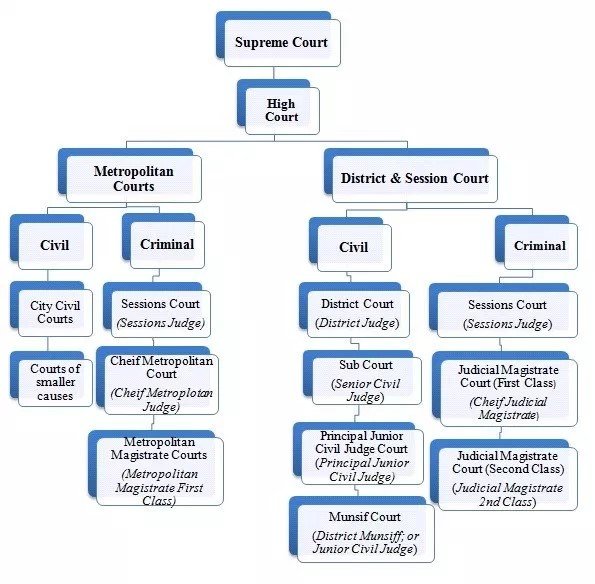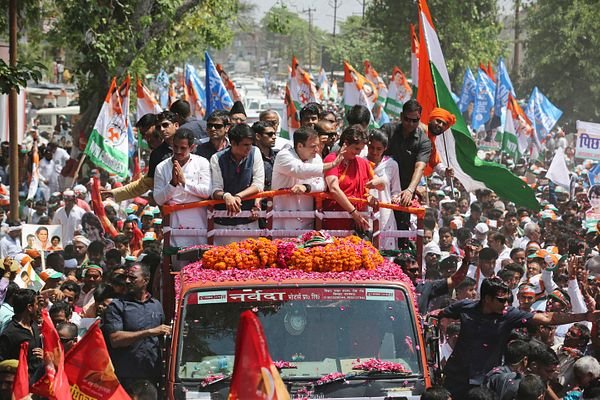The Indian judiciary is in charge of interpreting and enforcing the law, making it an essential component of the government. The Supreme Court sits at the top of the judiciary’s hierarchy, followed by the High Courts and the lower courts. Other duties of the judiciary include advising the government on legal matters and hearing appeals from lower courts.
Indian Judiciary’s Organization and Structure
- The Indian judiciary is organized in a hierarchical manner, with the Supreme Court sitting at the top, followed by the High Courts and the lower courts.
- India’s highest court of appeal is the Supreme Court. It consists of the Chief Justice and thirty additional judges appointed by the Indian President. Original, appellate, and advisory jurisdiction are all vested in the Supreme Court.
- There are High Courts beneath the Supreme Court.
- They control the territory of a state or a union. A Chief Justice and any other number of judges Parliament may choose are the members of each High Court.
- District Courts, Taluka Courts, Munsifs Magistrates’ Courts, and Village Panchayat Courts are examples of subordinate courts.
Structure of India’s Judiciary
The Supreme Court
On January 28, 1950, the Supreme Court of India took over for the Federal Court of India and the Judicial Committee of the Privy Council. It is the nation’s highest court and the final appeals court. One Chief Justice is among its 31 judges. All lower courts in the nation are bound by the precedents and decisions set by the court. The Constitution of India’s Articles 124 to 147 address the Supreme Court’s powers and jurisdiction.
The High Courts
All of India’s High Courts are on the same level and have the same authority. There are a total of 25 high courts, each of which has jurisdiction over at least one state. The Supreme Court has the power to overturn the decisions of the High Courts. The High Court’s jurisdiction and powers are the subject of Articles 214 to 231.
The District Courts
The High Courts are above the District Courts. These are located in districts and handle both civil and criminal cases. The Sessions Courts are referred to as the District Court when dealing with criminal cases. Articles 233 to 237 give the District Court and other subordinate courts their authority.
Functions of Indian Judiciary
Administration of justice
- India’s judiciary is crucial to the people’s access to justice. The courts settle all legal disputes, and the judges ensure that the wronged party receives justice. When their fundamental rights are violated, citizens have the right to approach the Supreme Court under Article 32 and the High Courts under Article 226 of the constitution.
- This demonstrates that the judicial system intends to swiftly serve justice and eliminate all forms of injustice. The courts have repeatedly prioritized the need for justice and stood up for what is right, even when it meant going against the majority to serve minorities. For instance: In the Sabarimala case, despite widespread opposition from the majority, it was decided that women could still enter the temple.
Legislative interpretation and application
- The judiciary interprets and applies laws enacted by Parliament. A specific substantive and procedural law is enacted by Parliament, and the judiciary is tasked with providing an accurate interpretation and application of that law.
- If the words in the statute were interpreted in their literal sense, sometimes the case at hand would be unfair. In these situations, the courts have the authority to change the meaning of the statute to make it fit the situation. For instance: In the 1967 case of the State of Madhya Pradesh v. Azad Bharat Financial Company, the High Court altered the meaning of an Opium Act, 1950 provision to prevent vehicle owners from being wronged.
Making laws
- In India, the primary legislative body is the Parliament. After a lengthy process that includes votes by both Houses and the President’s assent, bills are introduced in Parliament and enacted. Although it is accountable for the majority of current laws, it is not the only body that makes laws. In India, the judiciary is also able to make laws.
- This is accomplished by the Supreme Court by issuing judgments that all lower courts must abide by. When handling cases, the lower courts must adhere to the Supreme Court’s precedents.
- The Indian constitution’s Article 227 grants the High Courts supervisory authority over the lower courts. This means that, with the exception of armed forces-related courts and tribunals created by law, the High Courts are able to oversee how all courts and tribunals under their jurisdiction operate.
- The High Courts have the authority to exercise judicial superintendence over their subordinate courts in addition to the power to supervise administrative matters. This authority can be exercised on behalf of an aggrieved party or alone. When necessary, it can transfer cases to itself from the subordinate courts.
Judicial review
- The Indian judiciary is very active in stopping the Parliament from passing laws that affect citizens’ fundamental rights. The Supreme Court declares any law that violates people’s rights unconstitutional, and that law ceases to exist. If this power had only been used when a case went to court, it would have been limited.
- However, fortunately, it is not restricted because the Court is able to review Parliament’s rules and legislation and take cognizance on its own. For instance, the Supreme Court ruled that Section 303 of the Indian Penal Code, 1860 was unconstitutional in Mithu v. State of Punjab (1983). As a result, the judiciary safeguards citizens’ fundamental rights and the constitution.
Arbitrator
- According to Article 131, when disputes arise between states or between a state and the federal government, the Supreme Court acts as an arbitrator. In the case of State of Karnataka v. Union of India (1977), for instance, it was decided that the Centre can issue directions to a state as a legal entity rather than as a geographical unit under Article 256.
Advisory
- The Indian Constitution’s Article 143 states that the judiciary has advisory jurisdiction. When there is a significant legal question or a matter of public importance, the President of India has the authority to refer cases to the Supreme Court. The President is not bound by this advice.
Judicial investigations
- The Indian judiciary has the authority to establish inquiry commissions to investigate concerns that necessitate expert intervention. When it becomes clear that the government or the executive branch has not exercised due care when dealing with a serious matter, this power is used. For instance, the Supreme Court set up an inquiry commission to look into a police encounter involving arrested people in Hyderabad. In May 2022, the commission released its report, which it presented to the Supreme Court.
Criticism of the Indian judicial system
Despite the fact that it is one of the most important parts of the government and protects citizens’ rights, the judiciary still gets criticized. It has been criticized by numerous individuals for various reasons, which we will discuss.
- Judge appointments are not made in a transparent manner: using the collegium method.
- High number of pending cases: Justice is denied when it is delayed. William Ewart Gladstone wrote this line in 1868. But has the judiciary, which is the only organization accountable for ensuring justice, adopted this? Over 4.5 million cases were pending in all Indian courts as of September 2021, according to PRS Legislative Research data.
- Not being represented in higher courts: It is abundantly clear that there is a dearth of female judges. The representation of women in the judiciary is also a topic that is always brought up in the farewell speeches of judges, just like the pending cases are.
- Incompetence: Corruption may not be completely absent from the judiciary. Over the years, a plethora of allegations have been leveled against powerful individuals for bribery or getting the day they wanted in court. S. P. Bharucha, a former Chief Justice of India, has stated that 20% of the higher judiciary may be corrupt.
- Excessive judicial power: As the name suggests, it refers to judicial overreach of authority or jurisdiction. Some refer to it as “judicial adventurism.” Overreach typically occurs when the judiciary begins to interfere with the legislature’s or executive’s authority or powers under the guise of judicial activism.





